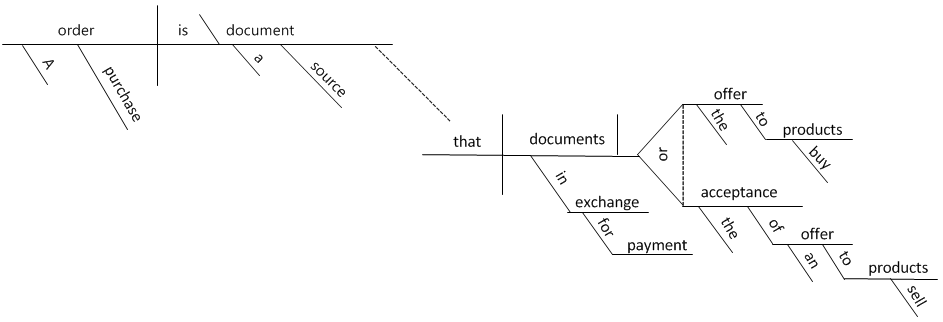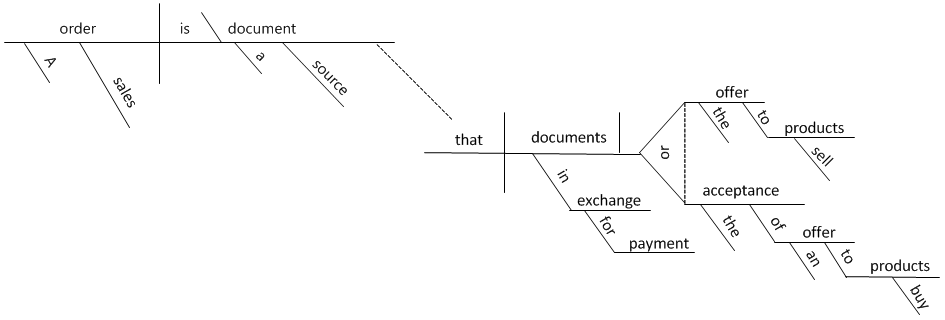How the practice of diagramming sentences enables our terminology practice
Who remembers how to diagram a sentence?
For those of you for whom sentence diagramming is a distant memory, let me kindly offer a refresher—diagramming sentences is the practice of visually representing the grammatical structure of a sentence by differentiating the parts of a sentence that comprise a thought or a concept. The goal of this practice is to promote the logical rules of syntax and word structures.
How the practice of diagramming sentences aligns with the practice of defining concepts
Early in our development cycle, we noted a lack of writing patterns with respect to the sentence structures for defining concepts. We discovered that random combinations of phrases emerged, many of which did not follow established good writing practices.
We discovered that when stakeholders were not able to describe concepts with respect to their domains or to name them, their practice was to write complex sentences that describe the purpose of concepts or the usage of concepts. This practice has proven prone to misalignments and inconsistencies in phrasing and inaccuracies in intended meanings. Feedback from our translation teams also confirmed that these misalignments, inconsistencies, and inaccuracies in applying the logical rules of syntax and word structures have affected the clarity and accuracy of translated text.
To address this challenge for stakeholders and for translators, we developed a terminology practice in which stakeholders elaborate conceptual object models that define and describe object structure and behavior in the real world. (For more information about elaborating models, see my earlier blog entry The origin of Microsoft Dynamics AX glossary entries).
To write the guidelines for definition authoring, we evaluated the components of a sentence and their relation to each other. Then we developed guidelines for defining concepts that follow the logical rules of syntax and word structure and for establishing sentence patterns.
The output of applying the guidelines during the development cycle has produced consistency in sentence patterns that are written to define concepts. We also learned that the consistency in sentence patterns has enabled consistency and precision in translation.
While the application of the practice of diagramming sentences has informed guidelines for our terminology process, this certainly does not mean that my colleagues and I spend our days diagramming sentences or memorizing the parts of speech and the rules of grammar and syntax. What it does mean is that the guidelines that we offer for defining concepts are rooted in established fundamental writing practices that include the logical rules of grammar, syntax, and word structures.
Testing the guidelines
To determine whether the guidelines would yield consistency and accuracy in concept definitions, we put our guidelines to a test. We diagrammed the sentences that were authored by following the guidelines that we wrote. Then we evaluated whether the definition was interpreted accurately with respect to the concept in the domain as defined in its respective conceptual object model. Where there were differences among the conceptual object model or the written definition and its corresponding sentence diagram, we learned that we needed to add or modify guidelines, particularly with respect to writing complex or compound definitions.
Aligning concepts and diagrams
I offer an example of Microsoft Dynamics AX source document concepts and their diagrams below. In the following term entries, you can see sentence patterns that are used consistently.
- production order – A source document that documents the requirements for producing items to meet a demand.
- purchase order – A source document that documents the offer to buy products or the acceptance of an offer to sell products in exchange for payment.
- sales order – A source document that documents the offer to sell products or the acceptance of an offer to buy products in exchange for payment.
In the diagrams below that correspond to these defined concepts, you can see how the components parts of each sentence align to the component parts in the other sentences and how they validate the real-world concepts as they are defined with respect to the domain and their respective conceptual object models.
production order
purchase order
sales order
Just for fun . . .
Can you read the definitions offered in the following diagrammed sentences?
To see whether your reading matches the definition we documented, click the linked term to go to its term entry in the Microsoft Dynamics AX glossary.







